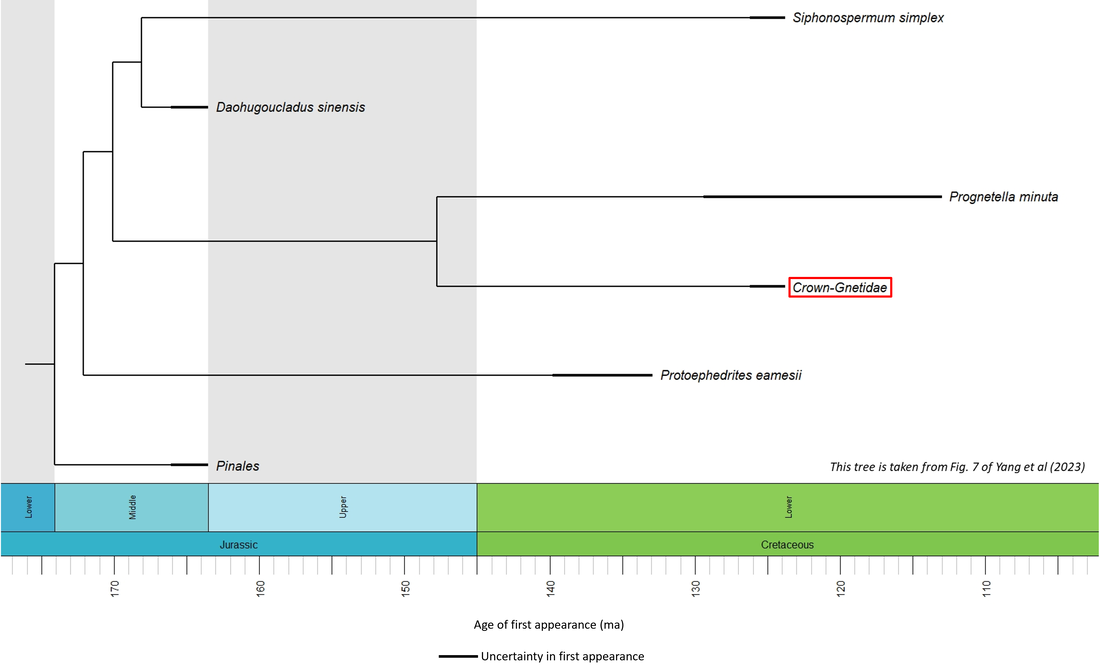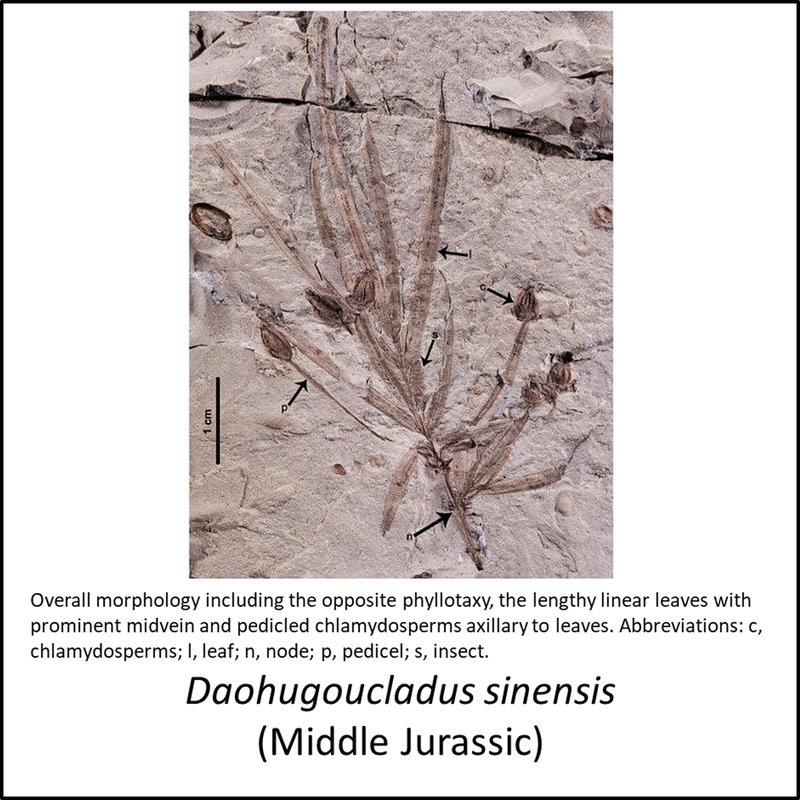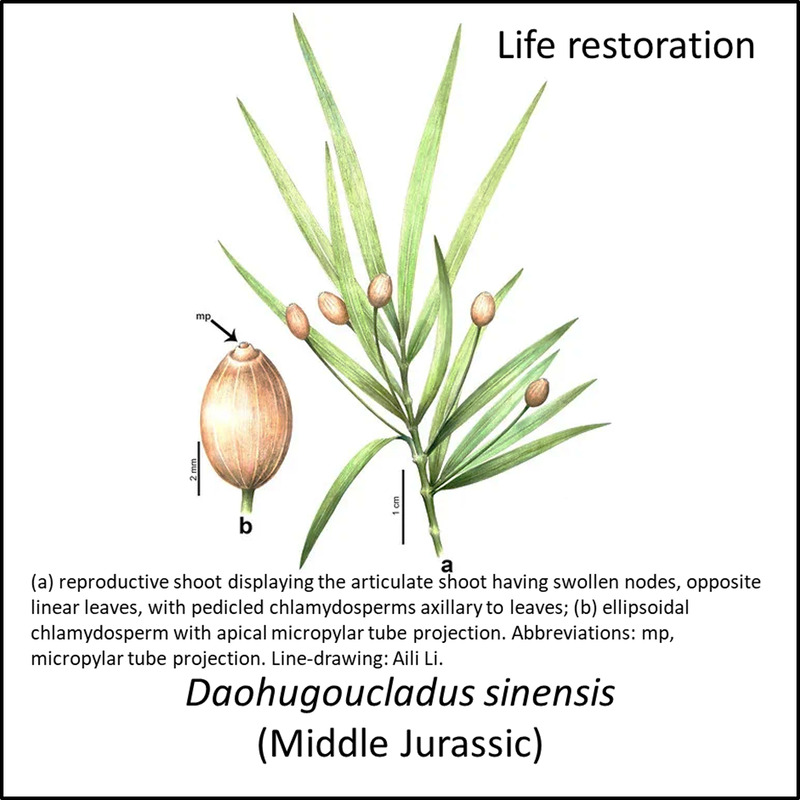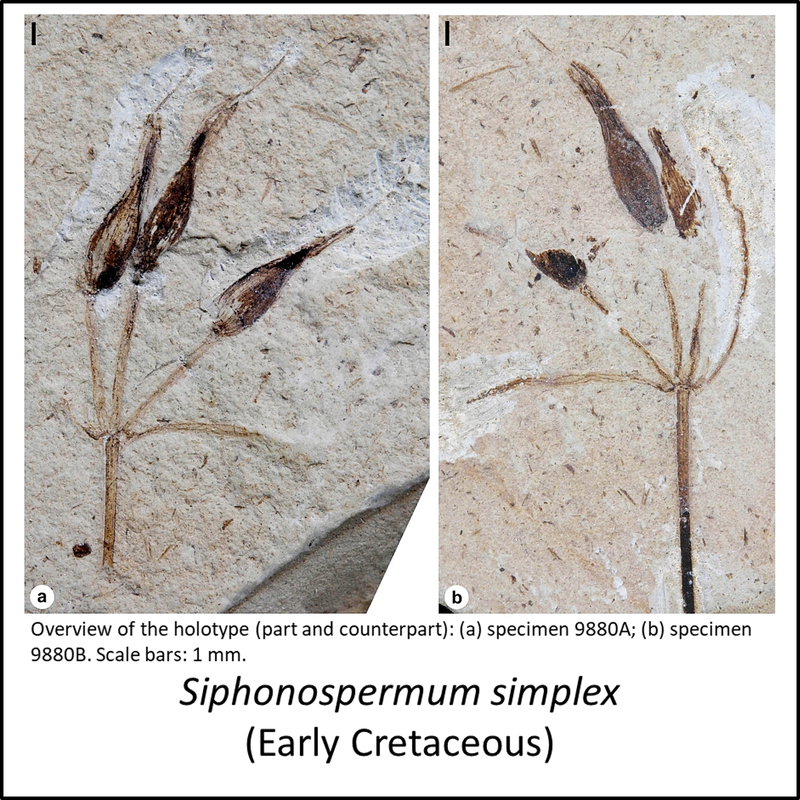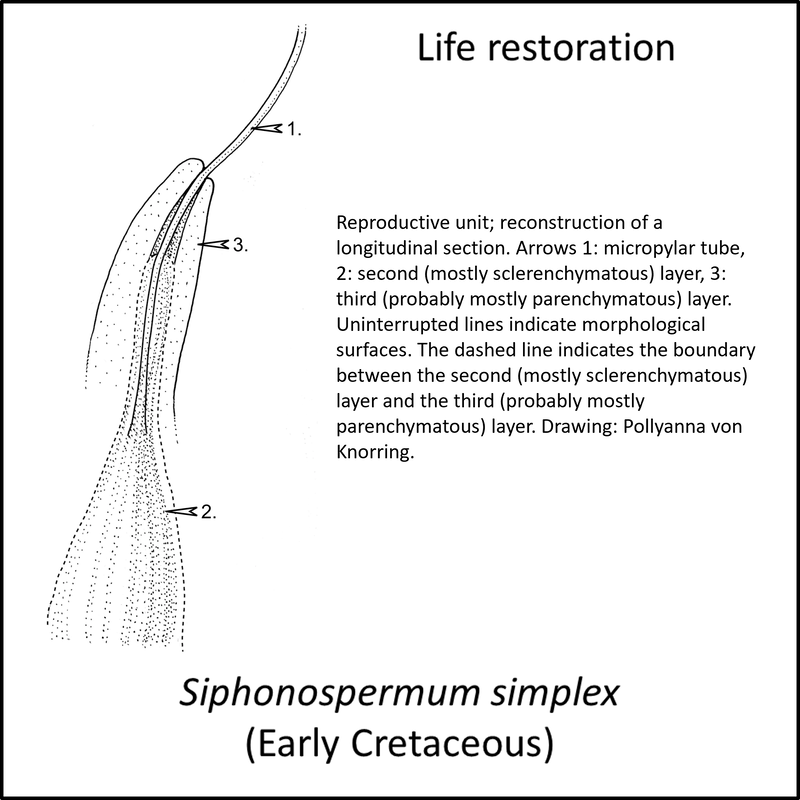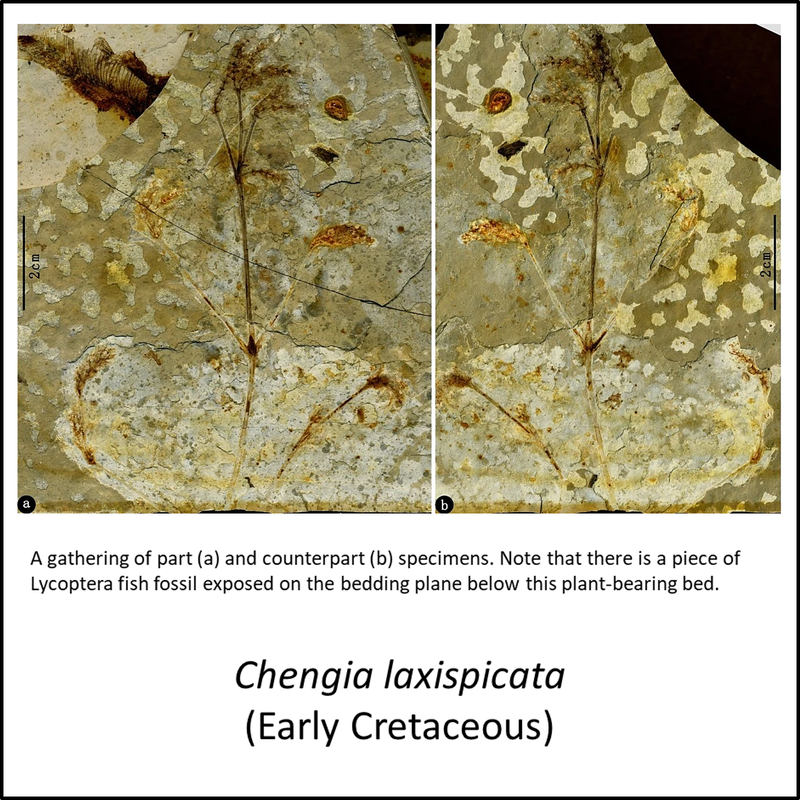The gnetophytes (subclass Gnetidae, subphylum Spermatophytina) are distinguished from other gymnosperms in having vessels in the xylem. This is also a characteristic of the flowering plants (angiosperms), and some aspects of gnetophyte cones resemble those of flowers. There are 96 species of gnetophyte, divided between three living genera: Ephedra, Gnetum (example pictured above), and Welwitschia (Encyclopaedia Britannica). These genera corresponds to three orders: the Ephedrales, the Gnetales and the Welwitschiales. Note that this nomenclature follows the gymnosperm classification presented by Yang et al (2022); many older articles use the term Gnetales as an order that contains three families, Ephedraceae, Gnetaceae and Welwitschiaceae.
Research for this website has not encountered any publication that presents a phylogenetic tree for the gnetophytes together with the morphological characteristics on which the tree is based. The following time tree represents “supposed relationships among fossil gnetophytes” according to its authors (Yang et al, 2023). We will assume that the tree has a valid basis in phylogenetic analysis of morphological characteristics.
Research for this website has not encountered any publication that presents a phylogenetic tree for the gnetophytes together with the morphological characteristics on which the tree is based. The following time tree represents “supposed relationships among fossil gnetophytes” according to its authors (Yang et al, 2023). We will assume that the tree has a valid basis in phylogenetic analysis of morphological characteristics.
Figure 1. Summarized phylogenetic tree of the stem-Gnetidae
The oldest known member of the stem-Gnetidae is Daohugoucladus sinensis, described from the Middle Jurassic (Callovian) Daohugou Formation at Daohugou Village, Ningcheng County, Inner Mongolia, China (Yang et al, 2023). This fossil is illustrated below, together with the only other member of the stem group for which public-domain images are available, Siphonospermum simplex (for a larger view, click on image):
Figure 2. Images of stem-Gnetidae
With only two species illustrated, we cannot make any comment on evolutionary developments through the gnetophyte stem-to-crown transition.
The oldest members of the gnetophyte crown group have all been found in an important lagerstätte in Liaoning province of NE China: the Yixian Formation of Early Cretaceous (Late Barremian - Early Aptian) age (Zhong et al, 2021). The species with the best images available in the public domain (shown below; click on image for a larger view) is the stem-Ephedrales member Chengia laxispicata, described from the lower part of the Yixian Formation at Dawangzhangzi Village, Songzhangzi Town, Lingyuan City, Chaoyang District, Liaoning Province, China (Yang et al, 2013; 2023):
The oldest members of the gnetophyte crown group have all been found in an important lagerstätte in Liaoning province of NE China: the Yixian Formation of Early Cretaceous (Late Barremian - Early Aptian) age (Zhong et al, 2021). The species with the best images available in the public domain (shown below; click on image for a larger view) is the stem-Ephedrales member Chengia laxispicata, described from the lower part of the Yixian Formation at Dawangzhangzi Village, Songzhangzi Town, Lingyuan City, Chaoyang District, Liaoning Province, China (Yang et al, 2013; 2023):
Figure 3. Images of one of the oldest members of the crown-Gnetidae
As indicated in Figure 1, the gnetophyte stem-to-crown transition took place over a period of at least 37 million years, from Middle Jurassic to Early Cretaceous time.
References
Doyle, J. A. (2006). Seed ferns and the origin of angiosperms. The Journal of the Torrey Botanical Society, 133(1), 169-209.
Yang, Y., Lin, L., & Wang, Q. (2013). Chengia laxispicata gen. et sp. nov., a new ephedroid plant from the Early Cretaceous Yixian Formation of western Liaoning, Northeast China: evolutionary, taxonomic, and biogeographic implications. BMC Evolutionary Biology, 13, 1-13.
Yang, Y., Ferguson, D. K., Liu, B., Mao, K. S., Gao, L. M., Zhang, S. Z., ... & Zhang, Z. X. (2022). Recent advances on phylogenomics of gymnosperms and a new classification. Plant Diversity, 44(4), 340-350.
Yang, Y., Yang, Z., Lin, L., Wang, Y., & Ferguson, D. K. (2023). A New Gnetalean Macrofossil from the Mid-Jurassic Daohugou Formation. Plants, 12(9), 1749.
Zhong, Y., Huyskens, M. H., Yin, Q. Z., Wang, Y., Ma, Q., & Xu, Y. G. (2021). High-precision geochronological constraints on the duration of ‘Dinosaur Pompeii’ and the Yixian Formation. National Science Review, 8(6), nwab063.
Yang, Y., Lin, L., & Wang, Q. (2013). Chengia laxispicata gen. et sp. nov., a new ephedroid plant from the Early Cretaceous Yixian Formation of western Liaoning, Northeast China: evolutionary, taxonomic, and biogeographic implications. BMC Evolutionary Biology, 13, 1-13.
Yang, Y., Ferguson, D. K., Liu, B., Mao, K. S., Gao, L. M., Zhang, S. Z., ... & Zhang, Z. X. (2022). Recent advances on phylogenomics of gymnosperms and a new classification. Plant Diversity, 44(4), 340-350.
Yang, Y., Yang, Z., Lin, L., Wang, Y., & Ferguson, D. K. (2023). A New Gnetalean Macrofossil from the Mid-Jurassic Daohugou Formation. Plants, 12(9), 1749.
Zhong, Y., Huyskens, M. H., Yin, Q. Z., Wang, Y., Ma, Q., & Xu, Y. G. (2021). High-precision geochronological constraints on the duration of ‘Dinosaur Pompeii’ and the Yixian Formation. National Science Review, 8(6), nwab063.
Image credits – stem-Gnetidae
- Header (Gnetum gnemon, photographed in 2012 in West Java, Indonesia): gbohne from Berlin, Germany, CC BY-SA 2.0 <https://creativecommons.org/licenses/by-sa/2.0>, via Wikimedia Commons
- Figure 2 (Daohugoucladus sinensis, fossil): From Open Access article Yang, Y., Yang, Z., Lin, L., Wang, Y., & Ferguson, D. K. (2023). A New Gnetalean Macrofossil from the Mid-Jurassic Daohugou Formation. Plants, 12(9), 1749.
- Figure 2 (Daohugoucladus sinensis, life restoration): From Open Access article Yang, Y., Yang, Z., Lin, L., Wang, Y., & Ferguson, D. K. (2023). A New Gnetalean Macrofossil from the Mid-Jurassic Daohugou Formation. Plants, 12(9), 1749.
- Figure 2 (Siphonospermum simplex, fossil): From Open Access article Rydin, C., & Friis, E. M. (2010). A new Early Cretaceous relative of Gnetales: Siphonospermum simplex gen. et sp. nov. from the Yixian Formation of Northeast China. BMC evolutionary Biology, 10(1), 1-6.
- Figure 2 (Siphonospermum simplex, life restoration): From Open Access article Rydin, C., & Friis, E. M. (2010). A new Early Cretaceous relative of Gnetales: Siphonospermum simplex gen. et sp. nov. from the Yixian Formation of Northeast China. BMC evolutionary Biology, 10(1), 1-6.
- Figure 3 (Chengia laxispicata, fossil): From Open Access article Yang, Y., Lin, L., & Wang, Q. (2013). Chengia laxispicata gen. et sp. nov., a new ephedroid plant from the Early Cretaceous Yixian Formation of western Liaoning, Northeast China: evolutionary, taxonomic, and biogeographic implications. BMC Evolutionary Biology, 13, 1-13.
- Figure 3 (Chengia laxispicata, life restoration): From Open Access article Yang, Y., Lin, L., & Wang, Q. (2013). Chengia laxispicata gen. et sp. nov., a new ephedroid plant from the Early Cretaceous Yixian Formation of western Liaoning, Northeast China: evolutionary, taxonomic, and biogeographic implications. BMC Evolutionary Biology, 13, 1-13.
